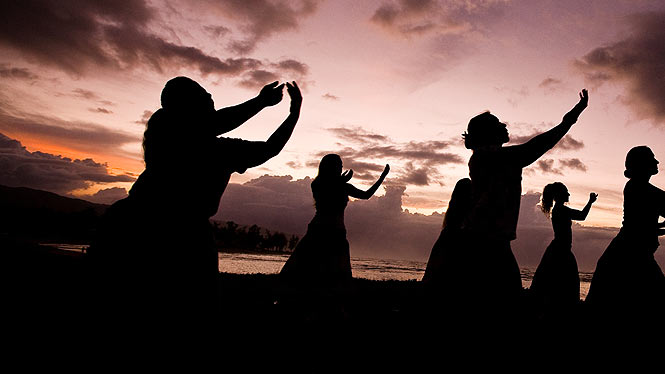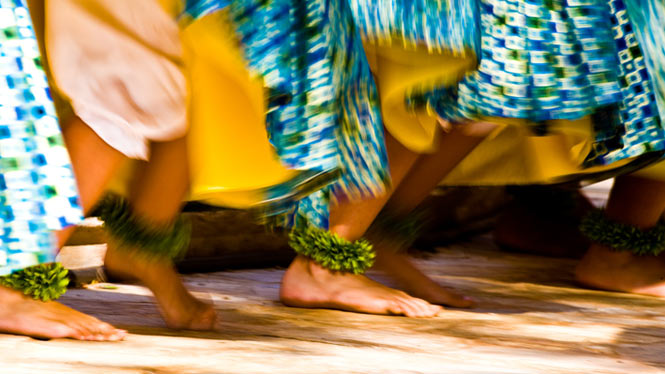
In the common imagination, Hawai’i has no more potent symbol than the hula dancer, usually a youthful beauty with a dreamy smile undulating to the rhythmic strums of a ukulele. Hollywood has long capitalized on that image and the world seems to love it. In 1926, Clara Bow, one of moviedom’s earliest sirens, lounged in a grass skirt beneath dripping banana leaves in Hula. Cute little Shirley Temple, animated Minnie Mouse, road sidekick Dorothy Lamour and Mr. Pelvis Elvis Presley were but four of the scores of other actors who have swiveled their hips in frequently farcical take-offs of Hawai’i’s ancient folk dance.
Far different from these showbiz representations, the hula in Hawai’i—in all of its sacred and ceremonial forms—was an integrated system of poetry, movement, and rhythm. The story surely wasn’t told in the lower body. And, forget the contemporary dictum to “keep your eyes on the hands.” No, the essence of ancient hula was in the words, the chant, without which, to the Hawaiian mind, there would be no dance. Gourds, drums, split bamboo sticks, and other instruments only supported the rhythm. Hula could be performed without instruments, but never without chanting. The chants themselves were complex, poetic and rich with multi-levels of meaning.
Origins of Hula
The origins of the hula are shrouded in mist, though its antecedents can be traced through Polynesia to India itself. While the acknowledged patron of the hula is the goddess Laka, a wealth of legends tell of the fiery goddess Pele, who searched for a home on each of the Hawaiian islands before settling into a volcanic cauldron on the Big Island of Hawai’i. Today, more than 300 sacred songs and chants recount the saga of Pele, her love for the chanter Lohi’au, and her sister Hi’iaka’s heroic journey to bring Lohi’au from his home on Kaua’i to Pele at the other end of the archipelago. Several versions of the Pele legend credit hula’s beginnings to Hi’iaka herself and to her mortal friend Hopoe, whom Pele destroyed in an impatient rage waiting for her sister to return with Lohi’au. Another account, part of a 928-line genealogy chant, tells of La’ila’i, who came to Hawai’i from the Marquesas. This legend locates the birthplace of Hawaiian hula on Moloka’i.
Beyond the legends and chants, ancient Hawai’i can be glimpsed through the eyes of Captain James Cook and his men. In 1778, they became the first Westerners to discover the Hawaiian Islands, and several in the expedition recorded their impressions of many facets of Hawaiian life, including the first hula performed for them shortly after their initial contact on Kaua’i.
Declaring Hula Illegal
Christian missionaries from New England arrived in Hawai’i in 1820 armed with Bibles, determination, and absolute certainty of their own, narrow ownership of the Truth. Many of the missionaries were appalled by the “noisy” and “heathenish” hula, and they made great efforts to abolish the dance, eventually convincing Christianized royalty to declare it illegal. But hula survived, beleaguered, perhaps, but zealously guarded and cherished by Hawaiians in locations remote from the many mission stations sprinkled through the islands.
The Return of Hula
King David Kalakaua, who came to the throne in 1874, is credited with returning the ancient hula to public enjoyment. Seemingly committed to Western goals, Kalakaua was elected king after he won the support of powerful planters and brokers by endorsing an open trade treaty for sugar between the U.S. and Hawai’i. Nicknamed the Merrie Monarch, King Kalakaua dressed in elaborate European-style uniforms, built the Victorian influenced ‘Iolani Palace for an enormous sum, and dined in Washington with President Grant. But, though he had learned the waltz, the minuet, and the two-step, Kalakaua had also mastered the ancient chants taught by his grandmother. He encouraged the hula (more than 260 chants and dances were performed at his coronation), and he spurred a proud and far-reaching resurgence of Hawaiian culture generally.
David Kalakaua did more for the hula, far more than reviving an ancient dance. During Kalakaua’s reign, the hula again became a “living tradition,” one that grew and evolved. Under Kalakaua’s patronage the Western forms of rhythm and melody, as expressed by hymn singing and band music, were amalgamated with the traditional hula forms. The ukulele, borrowed from Portuguese immigrants, was introduced, with its companion the steel guitar. And the ti leaf skirt was seen for the first time as a dance costume.
In 1893, two years into the reign of Queen Lili’uokalani, Kalakaua’s successor, the monarchy was overthrown by supporters of annexation to the United States. Hawaiian cultural expressions such as hula were swamped by the political turmoil and American hegemony that followed.

Though ignored, hula survived, both the ancient, rigid, semisacred forms whose carefully preserved movements could not be changed or amended and the hula ku’i (stitched or joined together) of Kalakaua’s era. In 1909, Nathaniel Emerson, the son of missionaries, would bring this indigenous art form to the attention of the outside world with the publication of his book, Unwritten Literature of Hawai’i, in which he carefully documented details such as the organization of a hula school, its ceremonies, aspects of training, costume, and graduation.
Emerson clearly loved hula. “If one comes to the study of the hula and its songs in the spirit of a censorious moralist,” wrote Emerson (referring to his missionary predecessors?), “he will find nothing for him; if as a pure ethnologist, he will take pleasure in pointing out the physical resemblances of the Hawaiian dance to the…geisha, or other Oriental dances. But if he comes as a student and lover of human nature, back of the sensuous posturings, in the emotional language of the songs he will find himself entering the playground of the human race.”
Soon after the book’s publication, the world discovered Hawai’i, and the tourist trade boomed. Hula played a central part in the packaging as semi-traditional hula was composed side-by-side with songs (often in English) and dances that bore little resemblance to things Hawaiian. The grass skirt which had been brought to Hawai’i by Gilbert Islanders became cellophane and the world partied out on Hollywood’s glitzy interpretation of Hawaiian glamour.
Still, many of the old chants and dances survived, handed down reverently from teacher to student in sanctuaries on each of the islands. In the 1970s, the dance emerged as part of a Hawaiian “renaissance” that continues today. The Merrie Monarch Festival, fittingly named for Kalakaua, who had revived the hula a century before, began in 1971 as a showcase of both ancient and modern hula. Scores of other hula pageants, competitions and foundations dedicated to preserving and perpetuating indigenous art forms are bringing the dances and chants of the Hawaiian people to the public eye. Today, the Hawaiian language is enjoying revived interest, bringing a new appreciation for the poetry of the ancient texts, with all of the complexities of thought and meanings-within-meanings that this subtle language offers.
Modern Hula
Currently in full swing is a creative debate on ancient hula—must it stand as a legacy pure and unadulterated or may it experience exciting and innovative interpretations? Modern hula, meanwhile, is pulsing with stimulating and experimental dances. The combination is a testament to the Hawaiian culture itself, both perpetuated and changed over the years, but steadfastly retaining its unique heritage and identity, which it continues graciously, with aloha, to share with all the world.